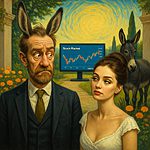The Emergent Irrationality of Crowds: A Multidisciplinary Analysis of Investing Behavior
Aug 28, 2024
Introduction: Unraveling the Complexity of Crowd Behavior in Investing
In the vast arena of financial markets, where fortunes are made and lost with the tick of a clock, a peculiar phenomenon emerges – the behaviour of crowds. According to emergent-norm theory, these crowds are often characterized as irrational, stupid, and reckless when it comes to investing. But is this a fair assessment? Or does it oversimplify a complex interplay of psychological, social, and economic factors? This essay aims to dissect this claim, drawing upon diverse fields of study and the insights of great thinkers to paint a more nuanced picture of crowd behaviour in investment scenarios.
To begin with, we must understand the foundations of emergent-norm theory. This theory, developed by Ralph H. Turner and Lewis M. Killian in the 1950s, posits that crowd behaviour is not inherently irrational or mindless. Instead, it suggests new norms emerge within a crowd as individuals interact and respond to novel situations. These emergent norms then guide subsequent behaviour, creating what may appear to outsiders as irrational or reckless actions.
However, when applied to investing, this theory takes on new dimensions. The financial markets are not merely a gathering of individuals but a complex adaptive system where information, emotion, and capital flow in intricate patterns. To truly understand crowd behaviour in this context, we must delve deeper into Mass psychology, behavioural finance, and even the cutting-edge field of neuroeconomics.
The Psychological Underpinnings of Crowd Behavior in Investing
Let us first consider the psychological underpinnings of crowd behaviour in investing. In his seminal work “The Crowd: A Study of the Popular Mind” (1895), Gustave Le Bon argued that individuals in a crowd lose their sense of identity and responsibility, becoming more susceptible to the contagion of emotions and ideas. This concept helps explain market bubbles and crashes when applied to financial markets.
For instance, consider the dot-com bubble of the late 1990s. As internet-based companies increased, a new norm emerged within the investing crowd – the belief that traditional valuation metrics no longer applied to these “new economy” stocks. This emergent norm led to what we can now see as irrational exuberance, with companies achieving astronomical valuations based on little more than a “.com” suffix. The subsequent crash in 2000 demonstrated the potential for crowd behaviour to lead to reckless investment decisions.
However, to dismiss all crowd behaviour in investing as irrational or stupid would be an oversimplification. Here, we can draw insights from behavioural finance, pioneered by psychologists Daniel Kahneman and Amos Tversky. Their work on prospect theory demonstrates that individual investors often make decisions based on cognitive biases and heuristics rather than purely rational analysis.
The Role of Information Cascades and Herd Behavior
When aggregated across a crowd, these individual biases can lead to what appears to be irrational behavior. For example, the disposition effect—the tendency of investors to hold onto losing stocks too long and sell winning stocks too quickly—can create market inefficiencies when exhibited by a large number of investors simultaneously. This is not necessarily stupidity or recklessness but rather a predictable outcome of human psychology applied to financial decision-making.
To further complicate matters, we must consider the role of information cascades in crowd behaviour. As articulated by economists Sushil Bikhchandani, David Hirshleifer, and Ivo Welch, information cascades occur when individuals observe the actions of others and then make the same choice, regardless of their private information. In investing, this can lead to herd behaviour, where investors follow the crowd rather than conduct their analysis.
This phenomenon was starkly illustrated during the GameStop short squeeze of 2021. A crowd of retail investors, coordinating through social media platforms, drove the stock price to unprecedented heights, seemingly defying fundamental analysis. Was this irrational and reckless behaviour? Or was it a new form of collective action enabled by technology and changing market dynamics?
Technical Analysis and Pattern Recognition in Crowd Behavior
To answer this question, we must turn to more advanced analytical tools. Often dismissed by proponents of the efficient market hypothesis, technical analysis offers insights into crowd psychology through the study of price patterns and market indicators. For instance, the Elliott Wave Theory, developed by Ralph Nelson Elliott in the 1930s, posits that market movements follow predictable patterns based on the psychology of the masses.
While controversial, the Elliott Wave Theory and similar technical approaches suggest that what appears to be irrational crowd behaviour may follow discernible patterns. This idea challenges the notion that investing crowds are purely stupid or reckless, instead implying that their behaviour, while perhaps not always rational in the traditional sense, may be predictable and exploitable.
Moving beyond traditional finance, the emerging field of neuroeconomics offers fascinating insights into the biological basis of investment decision-making. Studies using functional magnetic resonance imaging (fMRI) have shown that the brain’s reward centres activate not just when an individual makes a profitable investment but also when they conform to the decisions of a crowd. This suggests a neurological basis for herd behaviour in investing, complicating the simplistic view of crowds as irrational or stupid.
Complexity Theory and Emergent Properties in Financial Markets
Furthermore, applying complexity theory to financial markets reveals that crowd behavior in investing may be an emergent property of a complex adaptive system. Just as a flock of birds can exhibit complex, coordinated movements without central control, investing crowds can display behaviours that appear irrational at the individual level but serve a purpose at the system level.
For example, the seemingly reckless behavior of day traders, constantly buying and selling based on short-term price movements, actually increases market liquidity and efficiency. While any individual day trader may be taking on excessive risk, the aggregate effect of their actions benefits the market as a whole. This challenges the notion that all reckless behavior in investing crowds is detrimental or stupid.
When synthesizing these diverse perspectives, we must adopt a more nuanced view of crowd behavior. Rather than dismissing it as uniformly irrational, stupid, or reckless, we should recognize it as a complex phenomenon arising from the interaction of individual psychology, social dynamics, and systemic factors.
Evolutionary Psychology and Market Crashes
Consider, for instance, the phenomenon of market crashes. On the surface, the panic selling that characterizes a crash may appear stupid and reckless. However, it becomes more understandable when viewed through the lens of evolutionary psychology. In our ancestral environment, rapidly fleeing at the first sign of danger was often a successful survival strategy. In financial markets, this instinct can lead to seemingly irrational behaviour deeply rooted in our evolutionary past.
Moreover, the very concept of rationality in investing is worth examining. Based on the assumption of rational actors maximizing utility, traditional finance theory has been challenged by the realities of market behaviour. Herbert Simon’s concept of “bounded rationality” – the idea that rationality is limited by the tractability of the decision problem, the cognitive limitations of the mind, and the time available to make the decision – offers a more realistic framework for understanding investor behaviour.
In this light, what appears to be stupid or reckless behaviour may be a rational response to an overwhelmingly complex environment. When faced with the vast amount of information and the inherent uncertainties of the financial markets, investors may rationally choose to follow the crowd as a heuristic for decision-making.
The Impact of Technology on Crowd Behavior in Investing
Furthermore, the advent of algorithmic trading and artificial intelligence in financial markets adds another layer of complexity to crowd behavior. These technologies can amplify and accelerate human decision-making, leading to flash crashes and other phenomena that appear reckless but result from complex human and machine intelligence interactions.
As we look to the future, the nature of investing crowds is likely to evolve further. The democratization of finance through mobile trading apps and the rise of decentralized finance (DeFi) are changing the composition and behaviour of investing crowds. These developments may lead to new forms of collective intelligence in investing, challenging our notions of rationality and recklessness.
Conclusion: Towards a More Nuanced Understanding
In conclusion, while emergent-norm theory provides valuable insights into crowd behaviour in investing, characterizing these crowds as uniformly irrational, stupid, and reckless is an oversimplification. The reality is far more nuanced, involving a complex interplay of psychological, social, economic, and technological factors.
Instead of dismissing crowd behaviour, we should strive to understand it more deeply. We can better understand how investing crowds function by integrating insights from psychology, behavioural finance, technical analysis, neuroeconomics, and complexity theory. This understanding can lead to better investment strategies, more effective market regulations, and perhaps even new forms of collective financial decision-making that harness the wisdom of crowds while mitigating their potential for destructive behaviour.
As we navigate the ever-changing landscape of financial markets, let us remember that what appears irrational or reckless at first glance may, upon closer examination, reveal more profound truths about human nature and the complex systems we create. In the words of Isaac Asimov, “The most exciting phrase to hear in science, the one that heralds discoveries, is not ‘Eureka!’ but ‘That’s funny…'” Perhaps by approaching the seemingly irrational behaviour of investing crowds with this spirit of curiosity and inquiry, we can uncover new insights that will revolutionize our understanding of finance and human behaviour.















